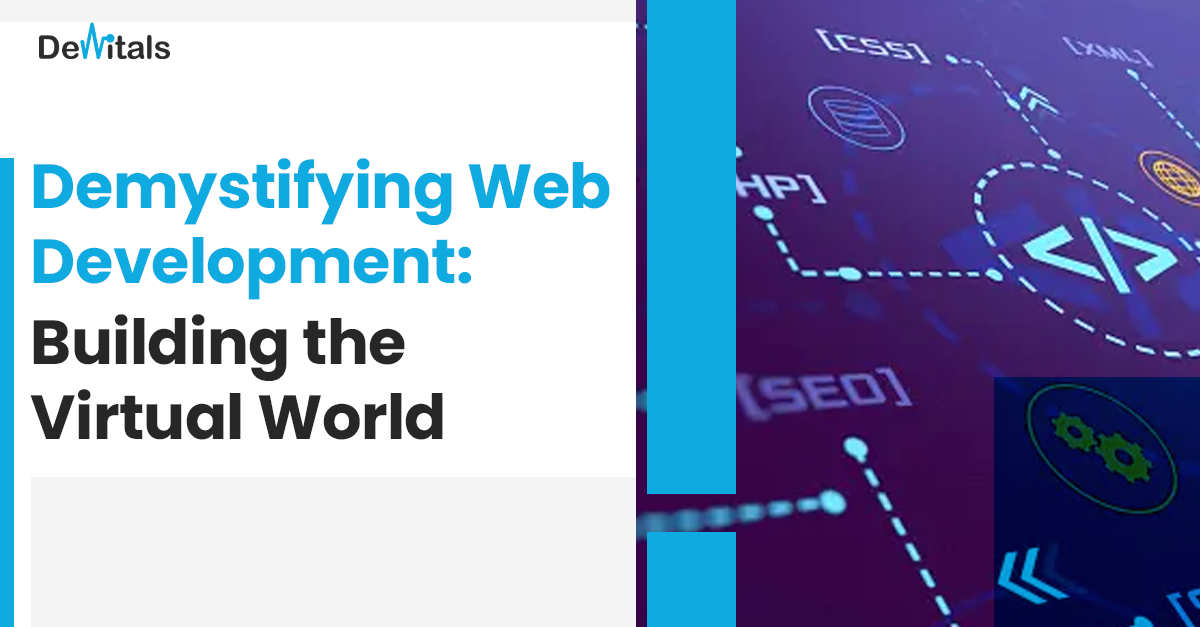In today’s digital age, the internet has become an integral part of our lives, connecting people, businesses, and information from all corners of the globe. At the heart of this interconnected world lies web development, the process of creating and maintaining websites and web applications that shape the virtual landscape we interact with daily. Whether you’re browsing social media, shopping online, or accessing valuable resources, it’s all made possible through the art and science of web development. In this blog, we’ll delve into the fundamentals of web development, explore its key components, and demystify the process behind building the virtual world.
1. Understanding Web Development:
Web development encompasses a diverse set of skills and technologies that work together to create websites and web applications. It involves both front-end development, which focuses on the visual and interactive aspects that users see and interact with, and back-end development, which involves server-side processes and handling data.
2. Front-End Development: The User Interface (UI):
Front-end developers are responsible for designing and implementing the user interface of a website. This includes designing layouts, selecting color schemes, typography, and creating interactive elements that users can engage with. The primary technologies used in front-end development are HTML (Hypertext Markup Language), CSS (Cascading Style Sheets), and JavaScript. HTML structures the content on the page, CSS styles, and formats it, while JavaScript adds interactivity and functionality.
Additionally, front-end developers often work with various frameworks and libraries like React, Angular, or Vue.js, which simplify the development process and enable the creation of more dynamic and responsive user interfaces.
3. Back-End Development: The Engine Under the Hood:
Back-end development deals with server-side operations and database management. This aspect of web development ensures that the front-end interfaces communicate effectively with the server and that data is processed and stored securely. Back-end developers primarily use programming languages such as Python, Ruby, PHP, Java, or Node.js to build the server-side logic.
In the back end, databases play a vital role in storing, retrieving, and managing data efficiently. Popular database management systems include MySQL, PostgreSQL, MongoDB, and more.
4. Full-Stack Development: Bridging the Gap:
A full-stack developer is someone who is proficient in both front-end and back-end development. Full-stack developers have a comprehensive understanding of the entire web development process and can work on all aspects of a project, from designing the user interface to managing databases and server operations. They are versatile professionals who can tackle various tasks and contribute to different stages of development.
5. Tools of the Trade:
Web developers rely on various tools and software to streamline their work and collaborate effectively. Integrated Development Environments (IDEs) like Visual Studio Code, Sublime Text, and JetBrains WebStorm are popular choices for coding, debugging, and version control. Version control systems like Git and collaboration platforms like GitHub enable teams to work together seamlessly and track changes in the codebase.
6. Web Development Paradigms:
Web development is not a one-size-fits-all endeavor. Different projects may require different approaches based on their complexity, scalability, and specific requirements. Two common paradigms are:
- Monolithic Architecture: In this traditional approach, the entire application is developed as a single unit. It’s easier to build and deploy but may become cumbersome to manage and scale as the application grows.
- Microservices Architecture: In this modern approach, applications are broken down into smaller, independent services, each serving a specific function. Microservices allow for better scalability, maintenance, and flexibility but come with increased complexity.
7. The Rise of Responsive Design:
With the proliferation of mobile devices, responsive web design has become a necessity. Responsive design ensures that websites adapt to different screen sizes and devices, providing an optimal user experience across smartphones, tablets, and desktops. CSS frameworks like Bootstrap and Foundation facilitate the development of responsive and mobile-friendly websites.
8. Security Concerns:
As the virtual world expands, so do security threats. Web developers must pay close attention to security practices to protect user data and prevent cyberattacks. Implementing HTTPS, input validation, and proper authentication mechanisms are essential steps to safeguarding web applications.
9. Web Development Trends:
Web development is an ever-evolving field, and staying up-to-date with the latest trends is crucial for developers. Some current trends include:
- Progressive Web Apps (PWAs): PWAs combine the best of web and mobile applications, providing users with fast, reliable, and engaging experiences, even in offline mode.
- Voice User Interface (VUI): Integrating voice technology into websites and applications to enable hands-free and intuitive interactions.
- WebAssembly (Wasm): A binary instruction format that allows running high-performance code written in languages like C, C++, and Rust directly in the browser.
Conclusion:
Web development is an intricate process that brings the virtual world to life. From designing captivating user interfaces to building robust back-end systems, web developers play a pivotal role in shaping our online experiences. As technology advances, the world of web development will continue to evolve, opening new possibilities for creating immersive and dynamic virtual spaces. Whether you’re a seasoned developer or a newcomer to the field, understanding the fundamentals of web development empowers you to contribute to and navigate the ever-expanding virtual realm. So, let’s embrace the journey of building the virtual world together, one line of code at a time.


